Last August we had made reservations to go on a Morning Game Walk today with two guides from Skukuzu Rest Camp. Steven and I met them at 4:15 but the other couple on the walk had forgotten their paperwork back at their hut so had to retrieve it before we got underway. Because Steven is a few years older than I, he had had to get a doctor's note saying he was fit and able to participate but the guides never asked for it - phooey!
We drove for 30 minutes to the spot where the walk finally began. I was so surprised that the sun had already risen by 4:30 as that seemed ungodly early. Israel, the lead guide, laid out the ground rules before we started our walk: walk in single file; limit talking to a whisper; click our fingers if we needed his attention; and, most importantly, if we were charged by an animal, stand our ground and do what we're told immediately and don't question anything we're told by him or Pilot, the other guide. The latter rule was somewhat scary, I assure you!
Our path sure looked safe enough.
Huge termite mounds:
Israel said this white rhino poo was territorial markings.
A huge pile of elephant poo:
I admit to being a little nonplussed when Israel picked up one clump of the poo and easily broke it into pieces. Surprisingly, the poo had no scent at all.
Elephants, Israel told us, had a very poor digestive system with just one stomach. They eat up to 16 hours a day. 40% of what elephants eat just passes directly through them.
A millipede only comes out in the summertime. (It was summertime then in South Africa as the seasons were the opposite of ours in North America.) Israel informed us that millipedes actually 'only' have 270 legs and not 1,000 like their name would suggest.
Oh wow, lucky us, more poo! This was impala poo.
A giant land snail which Israel jokingly said had lost its 'GPS' as it should be in the sea.
The snail, who has many enemies, hibernates in the winter until the rain comes and activates the snail.
Another termite mound. Termites, Israel informed us, are fungus growers who will dig as deep as the water table. The 'king, queen and prince termite soldiers' have mandible jaws. The worker termites collect dead plant material and provide food for the queen.
We learned that a termite mound is always open at the top for a constant internal temperature.
A dung beetle on some rhino poo: Closeups of the beetle are below.

Given its name, it wasn't a surprise to learn that the dung beetle feeds on dung. They are great for the environment because they eat flies. Male dung beetles roll the ball of dung to attract female dung beetles. Israel said the males have to work really hard to impress the female. Aren't they smart?!!
A while later, Israel noticed a porcupine quill on the ground. Inside the quill was a hole that expands when it pierces a lion or leopard to such an extent that they can be killed indirectly by a porcupine as the animals are so injured, they are unable to look for food.
Far off, we could hear the sound of a lion who was saying, according to Israel, he was there and this was his territory. It was comforting that one guide was always on the lookout for possible danger while the other talked to us when we stopped.
We next came across a natural pen or dam created by the recent rains. Kudus, elephants, zebras and other animals roll themselves in the mud before scratching themselves against trees to get rid of ticks.
A lone giraffe bone:
One of the few flowers we saw was this morning glory.
The guides followed by the couple who hailed from NY:
There were no doctors long ago so people had to rely on traditional healers. They made tea from the boiled roots from the silver cluster leaf tree.
Nearby was this very pretty tamboti flower but Israel cautioned us to be very careful near it as it had white latex which would blind us.
Israel next showed us this scented thorn tree. He described nature as being so amazing as browser animals like kudus and giraffes are only able to eat these trees for one hour before the tree produces tannin and 'communicates' the tannin to neighboring trees.

When we caught sight of this magic quarry bush, Israel said it was normally an indication there was water far below it.
If the sticks bent down, that meant there was water below and it acted like a divining rod. Women used the roots to paint their lips and the sticks were used as toothbrushes.
When Israel told us this African weeping wattle bush was used for toilet paper because of its softness, I thought of the Charmin ad also touting the softness of its tissue! However, since the weeping wattle bush had the same leaf pattern as the acacia tree, you need to be careful, according to Israel. For good luck, people put some of the leaves in their pockets. It only worked, though, if people believed in it. I was relieved that the guides still carried rifles just in case the weeping wattle leaves failed to work!
A lion footprint:
This very poisonous plant was called a String of Stars. Just one drop was enough to commit suicide.
This elephant footprint was as close as we got to seeing animals bigger than the millipede, dung beetle and the like. Much safer that way but not nearly as exciting, that's for sure!
This berry from the marula tree was an excellent source of Vitamin C. Israel mentioned that beer, juice and jam could be made from marula trees which were also popular with elephants.
Israel showed us the indirect damage done to this tree by an elephant who had scarred it. Over the last few days while driving in Kruger National Park, we had observed the direct damage elephants had also caused to so many trees by pushing them over.
I had wondered why the guides always walked ahead of us. Apparently, 99% of potential danger is always in the front while walking in the bush. That meant the guides were always walking into danger; the second guide acted as a backup in case the first guide's gun jammed. For safety purposes, no bullets were kept in the chamber.
These huge water holes had been dug by elephants.
After having walked for a couple of hours, it was nice to take a break and eat the breakfast that Israel, sitting down, and Pilot, standing up, had brought along for us.
I was glad that the fellow from NY asked Pilot if he had had to use his rifle on any game walks because I had been thinking the same thing and hadn't wanted to ask. Pilot answered he had had to shoot both a lion and a water buffalo but only as a last resort as the rangers' goal is to keep the animals safe. He mentioned that rhinos are not listed on the rest camps' Animal Sighting Boards because poachers would know where to go in the park to spot and kill them. He went on to say that there's a big market in China for rhino horns. There's no longer any market for elephant horns though because of a world-wide embargo on them.
While we had time to enjoy our 'breakfast in the bush,' Israel commented that none of the animals migrate in Kruger. When Kruger was proclaimed a national park in 1898, many people lived within its boundaries. He added that the park's current drought had been the worst since 1903 and that many hippos and buffaloes had been killed off in the drought because the soil wasn't healthy enough to support the animals.
The grass should have been normally knee-high in the summertime then, not sparse like this.
Another tree damaged by an elephant:
Old termite mounds: these ones, Israel knew, had nothing inside because there were cobwebs over top.
Israel knew this was urine from a white rhino. He mentioned that black rhinos prefer to stay in the bush.
The damage to this tree was caused by a buffalo 'horning' it.
This male giraffe bone had likely belonged to an animal who had died of old age because it had an extra bone that only grows when the animal grows old. When we said we thought we had seen so many pregnant zebras (not giraffes, Lil Red!!), Israel said they were actually just full of air and weren't likely pregnant.
As we neared the end of the walk, Israel stated that people see very few adult male lions in the park because of infanticide of male lions and male lion cubs don't prove to be good competitors.
What we thought and, quite frankly, had hoped was going to be a Game Walk turned out to be an expensive nature walk instead. We understood, though, that sighting animals was just was the luck of the draw.
After the walk ended at 7:45, we had a 30 minute ride back to the camp. We walked back to our little bungalow where we made some sandwiches and then were off again for a drive north to Tshokwane.
En route, we stopped briefly at the Kruger Tablets again to take photos of the tablets or signs themselves as I had neglected to do that when we were there yesterday.
It was interesting, or perhaps a tad gruesome, to observe grass growing among the bones of this carcass.
Even without any binoculars, Steven was able to spot the nyala in the distance.


While eating our sandwiches under this fever tree, Steven said he had anticipated the Sunset Drive and Morning Walk would have been the highlights of our five days in Kruger. We both agreed, however, that they had both been underwhelming compared to the drives we took ourselves each day. We figured, too, that we didn't 'need' to go on any more safaris in Africa, even if we are lucky enough to return to that continent one day.
We continued driving north, stopping at Satara Rest Camp for a bit. It was the farthest north we had been so far in the park but still was a good piece shy of the park's halfway point of Olifants Rest Camp.
It was cute seeing monkeys beyond Satara's electrified fence.
We headed north toward Olifants but, after driving a few miles and seeing very few animals and only very stark terrain, turned around and went back south again for a number of miles. We had then hoped to take a gravel road about 13 miles west to the Muzandzeni Lookout and then back south most of the way to Skukuzu eventually on another gravel road.
The gravel roads in the southern part of the park had been great, However, the ones we tried yesterday much further north and so far today were definitely not.
The lure of discovering another lookout and new roads was strong and the topography was certainly more varied but after a few miles, the road deteriorated so badly Steven felt safer turning around and returning to the tar road. If we'd rented an AWD car as we had in Oman, we could have managed the gravel roads.
It was 1:30 by then and, though we had been on the road driving for more than four hours, we had seen hardly any other traffic and almost no animals at all. We could only marvel at how incredibly lucky we'd been seeing so many and so close up the last few days. As we drove, we wondered if we'd seen our last nyala, our last elephant, zebra and giraffe - how sad.
We noticed the soils in this area of the park ranged from red to tan in color. We loved seeing the palm trees as there were so few of them further south.
A short way off the main north-south road was the Kumana water pool. According to a sign there, it had been donated by someone who loved the park. How, I wondered, could someone donate a water pool? The land for it, yes, I understood, but the pool itself?
Great seeing these hippos even if they were almost totally submerged.
If I remember my birds, I think this was an Egyptian goose. No guarantees though!
Our first sighting of a baby impala - yeah!
We got back to our humble abode in Skukuza Rest Camp by 4, far earlier than when we had returned any other day. But of course, since we had been up since before 4 am, we were both glad to take it easy.
Photos of our hut:
After the luxury of the Crocodile Safari Lodge where we had stayed for our first three nights just outside the southern entrance to the park, the hut's very compact interior wasn't quite as pleasant! We also had to pay a lot more for the hut than we had at the lodge. The upside, though, was definitely its location for anyone wanting to see the mid-section of the park. It was also neat experiencing camp life for a couple of nights.
Some of the huts had an open 'kitchen' area but ours was enclosed. The kitchen only comprised a fridge, microwave, table and an outdoor grill.
Don't these monkeys who were outside the camp's restaurant look adorable as all get out? I thought so, too, until we saw the mama monkey get extremely aggressive, grabbing food off plates, grocery bags filled with food and anything else not nailed down!
Even though we hadn't seen any 'exciting' animals today on either the morning walk or our drive, it had still been a great day as we learned a lot from the guides and also discovered new areas of Kruger. As we went to bed that night, it was hard to accept this had been our last full day in the park and we were leaving early in the morning for the long drive to Pretoria first, then back to Johannesburg before flying the next evening to Cape Town.
Posted on January 21st, 2017 from Littleton, Colorado.






























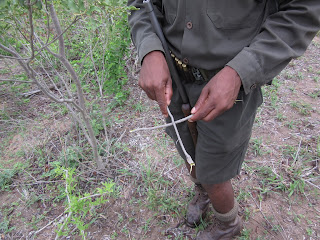



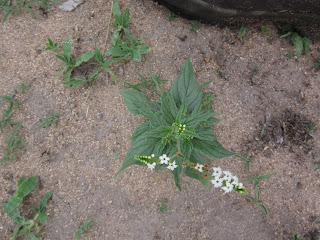






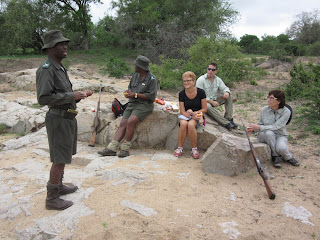






























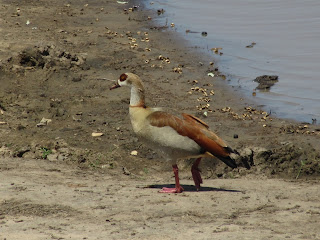


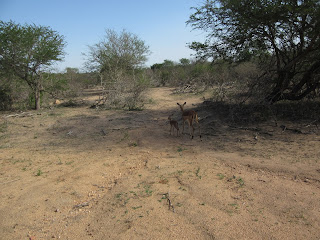








I am such a big chicken. There is no way l would have done this walk. I don't want to be that up close with any animal. Even those monkeys would have scared me. Too bad you didn't see the big wild life animals but good that you had a nice walk. I was amazed at the dung beetles too in Pilanesburg. We could see them rolling the dung on the road in front of the car..��
ReplyDeleteKemkem, Always easy to be 'brave' when you're not actually facing the animals but think you'd love to be doing so! We also marveled at a tiny dung beetle rolling a big ball of dung across the road when we were out on on our own game drives.
ReplyDelete